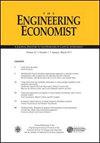Letter from the editor
IF 1.2
4区 经济学
Q4 BUSINESS
引用次数: 0
Abstract
This issue of The Engineering Economist demonstrates the wide array of application domains that benefit from engineering economic analysis. I would like to thank the reviewers who contributed to the peer-review process as well as associate editors Jo Min, David Enke, Karen Bursic, and Kyoung-Kuk Kim for their contributions to this issue. The issue begins with an article entitled “A Methodology for Temperature Option Pricing in the Equatorial Regions” by Cabrales, Bautista, Galindo, and Madiedo. The authors develop a methodology for temperature option pricing in equatorial regions. In their approach, temperature is forecasted by combining deterministic and stochastic models. The methodology is calibrated with data gathered in Bogot a, Colombia, using Monte Carlo simulations. They find the use of third-degree Fourier series and mean reversion prove most accurate for pricing temperature options. In “The Influence of Gender-Diverse Boards on Post-Audit Practices: A UK SME Study” by Lefley, Maresova, Hamplov a, and Jane cek, the research shows differences between gender diverse boards and male-only boards in post-audit practices. This article is of relevance and general interest to engineering economists in an investment appraisal, post-audit, project management, and governance environment and can facilitate fostering diversity and equality in regulating corporate activities and assist practitioners and policymakers in understanding the importance of monitoring capital projects. The next article “Case Study: An Assessment of the Economic Service Life of Research Equipment in the Korean Public Research Institutes” by Lee, Lee, Ri, Kim, and Park assesses the economic life of R&D equipment empirically using data gathered from public R&D institutes in Korea. As the effective use of research equipment has been regarded as a prerequisite condition to maximize research and development outcomes, the problem of replacing aging or obsolete research equipment has become important. The authors developed a systematic model to apply traditional engineering economic concepts and estimate the economic service life of research equipment based on size and utilization purpose of the equipment. The study suggests a policy scheme for efficient replacement of research equipment based on our estimation results. In the last article, Babaei and Jassbi coauthor “Technical Note: Modified Simple Average Internal Rate of Return.” Their technical note presents the Modified Simple Average Internal Rate of Return criterion as a profitability index for calculating a unique rate of return for all various types of cash flow streams so that obtained results are consistent with the net present value method in accept/reject decisions. The presented method is simple to compute and is capable of resolving all known IRR defects including when the resulting rate is greater than 1. The Engineering Economist journal publishes articles, case studies, surveys, and book and software reviews that represent original research, current practice, and teaching involving problems of capital investment. For questions or inquiries, please contact me at hln@uark.edu.编辑来信
本期《工程经济学家》展示了受益于工程经济分析的广泛应用领域。我要感谢为同行评审过程做出贡献的审稿人,以及副编辑Jo Min、David Enke、Karen Bursic和Kyoung-Kuk Kim对本期的贡献。本期杂志以Cabrales、Bautista、Galindo和madedo的一篇题为“赤道地区温度期权定价方法”的文章开篇。作者开发了赤道地区的温度期权定价方法。在他们的方法中,温度是通过结合确定性和随机模型来预测的。该方法是根据在哥伦比亚波哥大收集的数据,使用蒙特卡罗模拟进行校准的。他们发现使用三度傅立叶级数和均值回归被证明是最准确的定价温度选项。在Lefley、Maresova、Hamplov和Jane cek的《性别多元化董事会对审计后实践的影响:一项英国中小企业研究》中,研究显示了性别多元化董事会与纯男性董事会在审计后实践中的差异。这篇文章与工程经济学家在投资评估、审计后、项目管理和治理环境中的普遍兴趣相关,可以促进在规范公司活动中促进多样性和平等,并帮助从业者和政策制定者理解监控资本项目的重要性。由Lee、Lee、Ri、Kim和Park撰写的下一篇文章“案例研究:韩国公共研究机构研究设备经济使用寿命的评估”,通过从韩国公共研究机构收集的数据,对研发设备的经济使用寿命进行了实证评估。由于研究设备的有效利用已被视为最大化研究开发成果的先决条件,因此更换老化或过时的研究设备的问题变得重要起来。应用传统的工程经济概念,根据科研设备的尺寸和使用目的,建立了一个系统的模型来估算科研设备的经济使用寿命。在此基础上,提出了有效更新科研设备的政策方案。在上一篇文章中,Babaei和Jassbi共同撰写了“技术说明:修正简单平均内部收益率”。他们的技术说明将修正简单平均内部收益率标准作为一种盈利能力指数,用于计算所有不同类型现金流的唯一收益率,以便获得的结果与接受/拒绝决策中的净现值法一致。所提出的方法计算简单,能够解决所有已知的IRR缺陷,包括当结果率大于1时。《工程经济学家》杂志发表文章、案例研究、调查、书籍和软件评论,它们代表了涉及资本投资问题的原始研究、当前实践和教学。如有任何问题或疑问,请通过hln@uark.edu与我联系。
本文章由计算机程序翻译,如有差异,请以英文原文为准。
求助全文
约1分钟内获得全文
求助全文
来源期刊

Engineering Economist
ENGINEERING, INDUSTRIAL-OPERATIONS RESEARCH & MANAGEMENT SCIENCE
CiteScore
2.00
自引率
0.00%
发文量
14
审稿时长
>12 weeks
期刊介绍:
The Engineering Economist is a refereed journal published jointly by the Engineering Economy Division of the American Society of Engineering Education (ASEE) and the Institute of Industrial and Systems Engineers (IISE). The journal publishes articles, case studies, surveys, and book and software reviews that represent original research, current practice, and teaching involving problems of capital investment.
The journal seeks submissions in a number of areas, including, but not limited to: capital investment analysis, financial risk management, cost estimation and accounting, cost of capital, design economics, economic decision analysis, engineering economy education, research and development, and the analysis of public policy when it is relevant to the economic investment decisions made by engineers and technology managers.
 求助内容:
求助内容: 应助结果提醒方式:
应助结果提醒方式:


